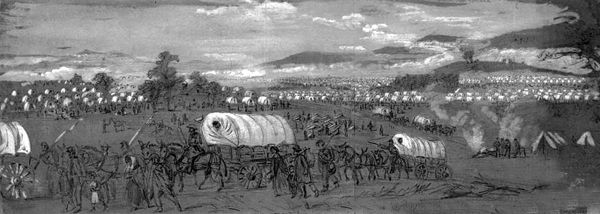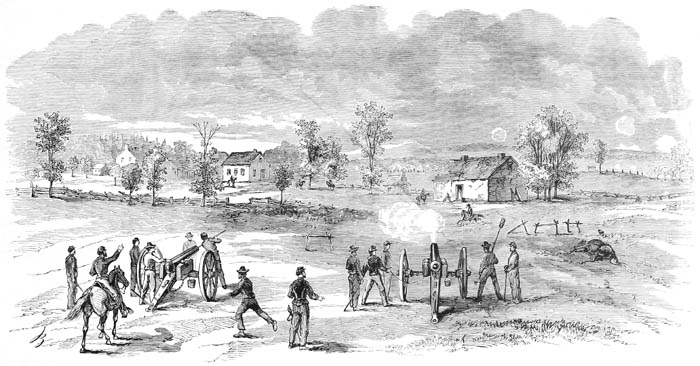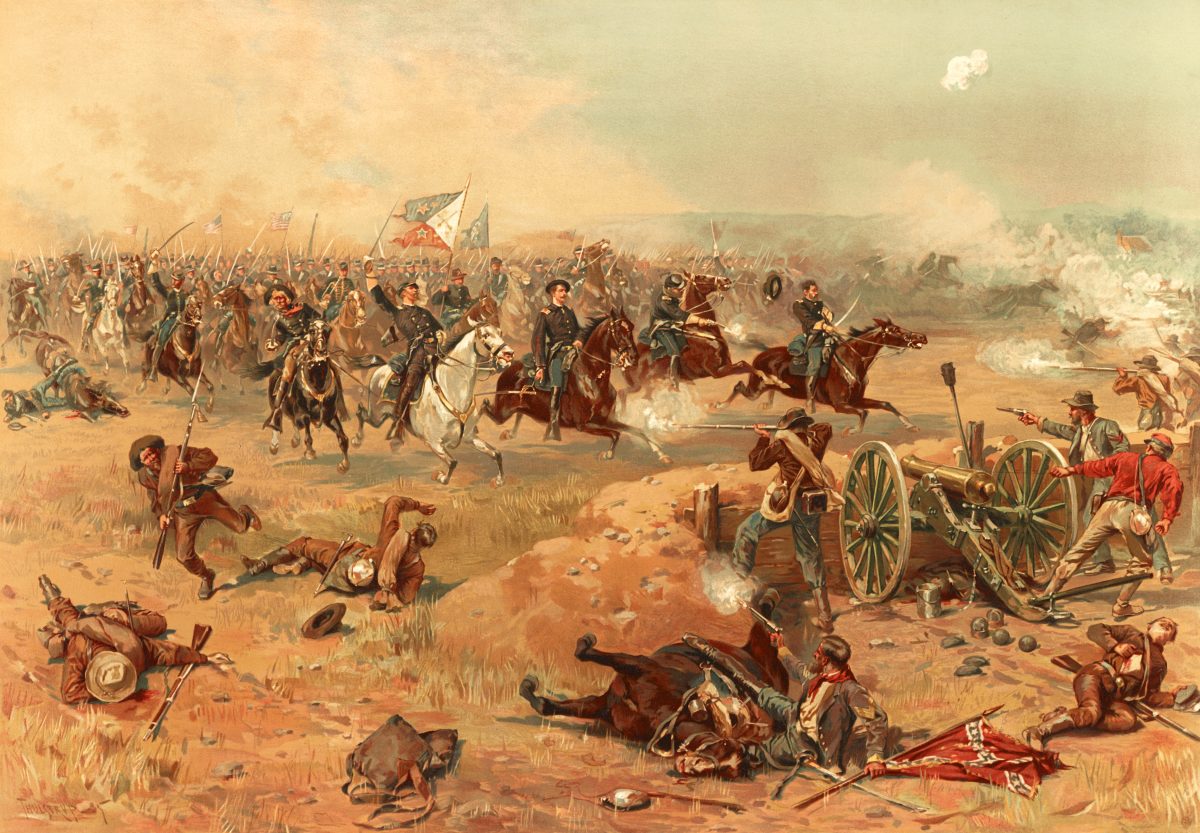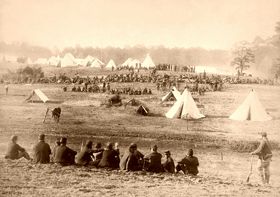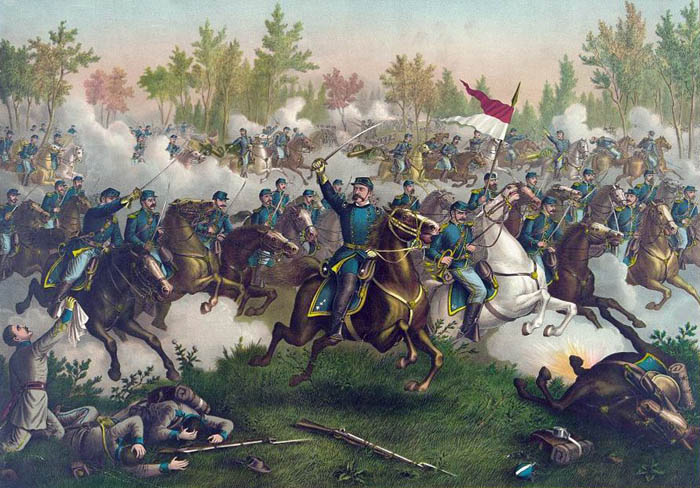By the summer of 1864, Lieutenant General Ulysses S. Grant had finally lost patience with the Confederates and knew that Washington D.C. remained vulnerable. After General David Hunter’s command of the forces ended after Early defeated him at the Battle of Lynchburg on June 19, 1864, Grant found a new commander aggressive enough to defeat Confederate General Jubal Early. That man was Union Major General Philip Sheridan, the cavalry commander of the Army of the Potomac, who was given command of all forces in the area, calling them the Army of the Shenandoah. Sheridan initially started slowly, primarily because the impending presidential election of 1864 demanded a cautious approach, avoiding any disaster that might lead to President Abraham Lincoln’s defeat. The campaign was fought mainly in Virginia, with a few skirmishes in West Virginia, and would include many battles between August and October 1864.
Guard Hill (August 16, 1864) – Also called the Battle of Front Royal and the Battle of Cedarville, this engagement occurred in Warren County, Virginia. Confederate General Joseph Kershaw’s infantry division and General Fitzhugh Lee’s cavalry, under Lieutenant General Richard Anderson (Army of Northern Virginia, I Corps), were sent from Petersburg to reinforce Lieutenant General Jubal A. Early’s army in the Shenandoah Valley. At Front Royal on August 16, the Union cavalry of Brigadier General Wesley Merritt’s division surprised the Confederate columns in mid-stream of the Shenandoah River, capturing about 300. The Confederates rallied and advanced, gradually driving the two Union brigades back to Cedarville. After dark, Merritt withdrew to Ninevah. The total estimated casualties in the inconclusive battle were 550.
Summit Point (August 21, 1864) – Also known as the Battle of Flowing Springs or Cameron’s Depot, this skirmish occurred in Jefferson County, West Virginia, near Charles Town. Simultaneously, General Sheridan concentrated his army near Charles Town, Confederate Lieutenant General Jubal A. Early and Major General Richard H. Anderson attacked the Union forces with converging columns on August 21. The Union forces fought effective delaying actions before withdrawing to near Halltown on the following day. The inconclusive battle resulted in approximately 1,000 casualties.
Smithfield Crossing (August 25–29) – This small battle was fought in Jefferson and Berkeley Counties of West Virginia. On August 29, two Confederate infantry divisions under Lieutenant General Jubal Early crossed Opequon Creek at Smithfield Crossing and forced Wesley Merritt’s Union cavalry division back to Charles Town. However, a counterattack from Union General James Ricketts’ infantry division stopped the Confederate advance. Afterward, the Rebel troops did not attempt another advance, and the battle was inconclusive. It was the last engagement of the Civil War to take place in West Virginia.
Berryville (September 3-4, 1864) – Taking place in Clarke County, Virginia, Major General Philip Sheridan’s divisions marched south from Halltown, reaching Berryville on September 3. Union General George Crook’s corps elements went into camp, and Confederate General Joseph Kershaw’s infantry division attacked with limited results. During the night, Lieutenant General Jubal A. Early brought up his entire army but found General Sheridan’s position too firmly entrenched to assault by daylight. General Early withdrew after dark behind Opequon Creek. The inconclusive battle resulted in an estimated total casualties of 500.
Opequon (September 19, 1864) – Also called the Third Battle of Winchester, this engagement occurred in Frederick County, Virginia, and was the largest and most desperately contested battle in the Shenandoah Valley. Joseph Kershaw’s infantry division left Winchester to rejoin General Robert E. Lee’s army at Petersburg, Lieutenant General Jubal A. Early renewed his raids on the B&O Railroad at Martinsburg, poorly dispersing his four remaining infantry divisions. On September 19, Union Major General Philip Sheridan advanced toward Winchester along the Berryville Pike with the VI and XIX Corps, crossing Opequon Creek. The Union advance was delayed long enough for Early to concentrate his forces to meet the main assault, which lasted several hours. Casualties were hefty. The Confederate line was gradually driven back toward the town. In the mid-afternoon, Union Brigadier General George Crook’s VIII Corps and the cavalry turned the Confederate left flank. Early ordered a general retreat. Confederate Generals Robert Rodes and Archibald Godwin were killed, and Generals Fitzhugh Lee, William Terry, Edward Johnson, and John Wharton were wounded. Union General David A. Russell was killed, and Generals John B. McIntosh, Emery Upton, and George Chapman were wounded. Because of its size, intensity, and result, many historians consider this the most important Shenandoah Valley conflict. The Union victory resulted in estimated casualties of 5,020 Union and 3,610 Confederate.
Fisher’s Hill (September 21-22, 1864) – This two-day engagement occurred in Shenandoah County, Virginia. Bloodied by its defeat at the Battle of Opequon on September 19, Lieutenant General Jubal Early’s army took up a strong defensive position at Fisher’s Hill, south of Strasburg. On September 21, the Union army advanced, driving back the skirmishers and capturing important high ground. On the 22nd, Union Brigadier General George Crook’s Corps moved along North Mountain to outflank Early and attacked about 4 pm. The Confederate cavalry offered little resistance, and the startled infantry could not face the attacking force. The Confederate defense collapsed from west to east as Major General Sheridan’s other corps joined in the assault. Early retreated to Rockfish Gap near Waynesboro, opening the Valley to a Union “scorched earth” invasion. Mills and barns from Staunton to Strasburg were burned in what became known as the “Burning” or “Red October.” The Union victory resulted in estimated casualties of 528 Union and 1,235 Confederate.
Tom’s Brook (October 9, 1864) – Also called the Battle of Woodstock Races, this engagement occurred in Shenandoah County, Virginia. After his victory at Fisher’s Hill, Major General Philip Sheridan pursued Confederate Lieutenant General Jubal Early’s army army army up the Shenandoah Valley to near Staunton. On October 6, Sheridan began withdrawing, as his cavalry burned everything deemed of military significance, including barns and mills. Reinforced by Confederate General Joseph Kershaw’s division, General Early followed. Confederate Major General Thomas Rosser arrived from Petersburg to take command of General Fitz Lee’s cavalry division and harassed the retreating Federals. On October 9, Union Brigadier General Alfred Torbert’s troopers turned on their pursuers, routing Generals Thomas Rosser and Lundsford Lomax’s divisions at Tom’s Brook. With this victory, the Union cavalry attained overwhelming superiority in the Shenandoah Valley. Estimated casualties included 57 Union and 350 Confederate.
Cedar Creek (October 19, 1864) – Also called the Battle of Belle Grove, this extensive engagement occurred in Frederick, Shenandoah, and Warren Counties of Virginia. At dawn, on October 19, 1864, the Confederate Army of the Valley under Lieutenant General Jubal Early surprised the Federal Army at Cedar Creek and routed the VIII and XIX Army Corps. Commander Major General Philip Sheridan arrived from Winchester to rally his troops and, in the afternoon, launched a crushing counterattack, which recovered the battlefield. Sheridan’s victory at Cedar Creek broke the back of the Confederate army in the Shenandoah Valley. President Abraham Lincoln rode the momentum of Sheridan’s victories in the Valley and General William T. Sherman’s successes in Georgia to re-election. The Union victory resulted in estimated casualties of 5,665 Union and 2,920 Confederate.
Compiled and edited by Kathy Alexander/Legends of America, updated February 2024.
See our Virginia Civil War Gallery HERE
Also See:
Eastern Theater of the Civil War
Western Theater of the Civil War
Civil War Trans-Mississippi & Pacific Coast Theaters
Lower Seaboard Theater & Gulf Approach of the Civil War
Sources:

